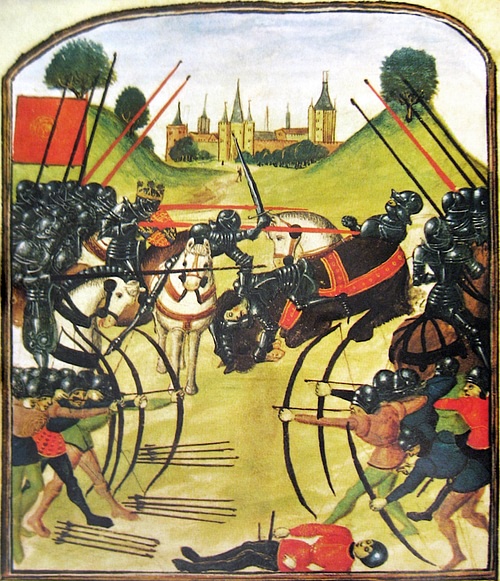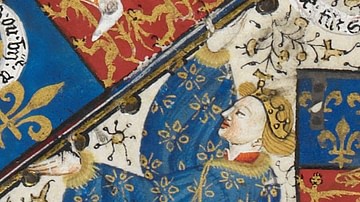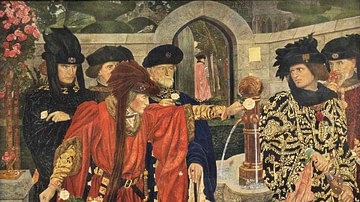
Edward IV of England ruled as king from 1461 to 1470 CE and again from 1471 to 1483 CE. The Hundred Years' War (1337-1453 CE) had been lost by Edward's predecessor, Henry VI of England (1422-1461 CE & 1470-1471 CE), leaving Calais as the only English territory in France. Henry's incompetence and episodes of insanity were important factors in the rivalry between the ruling house of Lancaster and the ambitious York family that developed into the conflict known today as the Wars of the Roses (1455-1487 CE). Richard, Duke of York (1411-1460 CE) had been ambitious to become king, and his son Edward took up the mantle from 1460 CE. Following his victories on the battlefield, Edward was crowned Edward IV the next year. There would be a brief interruption when his old ally the Earl of Warwick reinstated Henry VI in 1470 CE, but Edward would win back his throne, again on the battlefield, the next year. The king's second spell saw much more stability and a booming economy thanks to a peace treaty with France and the encouragement of cross-Channel trade. Edward died, perhaps of a stroke, aged 40 in 1483 CE and was succeeded by his young son Edward V of England (r. Apr-Jun 1483 CE) who was shortly after imprisoned and murdered, probably by his uncle the Duke of Gloucester who became Richard III of England (r. 1483-1485 CE).
Hundred Years' War: The Seeds of Discontent
The failures of the Hundred Years' War between England and France provided ambitious barons in England with an excuse to rid themselves of their talentless king. Henry VI provided no military leadership at all, and his marriage in 1445 CE to Margaret of Anjou (d. 1482 CE), niece of Charles VII of France (r. 1422-1461 CE), which involved the handing over of Maine, caused further division in England. Some barons resented the king's capitulation while others were angry that the hugely expensive war with France was still not at an end. The obvious influence of the queen on her weak-willed husband was yet another bone of contention amongst the court officials who were themselves seen as corrupt by outsiders. By 1453 CE the war was over, though, and the French had regained all English-controlled lands except Calais. It was then that Henry suffered his first episode of insanity which made him so incapable of ruling that Richard, Duke of York was nominated as Protector of the Realm, in effect, regent, in March 1454 CE.
Wars of the Roses
Richard was ambitious for the throne in the longer term. He did have a legitimate, if distant, claim to it as the great-grandson of Edward III of England (r. 1327-1377 CE) and the nephew of the Earl of March who himself had claimed he was the legitimate heir to Richard II of England (r. 1377-1399 CE). There was a serious rival, though, and this was the Earl of Somerset, also a descendant of Edward III but through that king's son John of Gaunt, father of Henry IV of England (r. 1399-1413 CE), first ruler of the House of Lancaster. Thus, two family groups were at odds: the house of York and the house of Lancaster, and each had allies amongst the nobility, which Henry VI had polarised through his interference in various disputes over the years. On top of that, the king's lack of an heir meant the field was open for anyone capable of pushing their claim via military victories. Consequently, the conflict we know today as the Wars of the Roses began. The name comes from the novelist Sir Walter Scott (1771-1832 CE) after the later badges of the two families (neither of which were actually the favoured liveries in the mid-15th century CE): a white rose for York and a red rose for Lancaster (who supported Henry VI). The wars were only intermittent and really only involved the nobility and their retainers and not the wider populace, indeed many of the battles were little more than skirmishes even if a few were large-scale affairs.
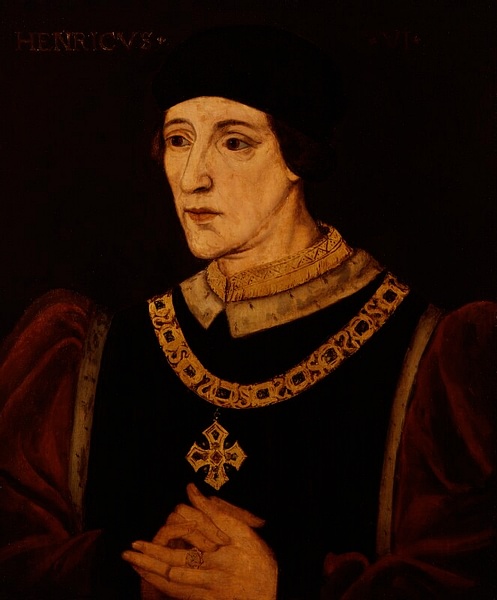
The Duke of York and the Earl of Somerset continued their rivalry until Somerset was killed at the Battle of St. Albans on 22 May 1455 CE. Richard then swore loyalty to Henry VI, probably realising the king could now be manipulated like a puppet. There was still one obstacle to Richard's ambitions, and this was the formidable figure of Henry's wife, Queen Margaret. The queen detested Richard, and she led an army to victory against him at the Battle of Ludford Bridge on 12 October 1459 CE. The Duke of York fled to Ireland while Parliament, the 1459 CE 'Parliament of Devils', identified him as a traitor and disinherited his heirs.
Edward Becomes King
It was into this complex chess game of thrones that Edward was thrust when he reached maturity. Born on 28 April 1442 CE in Rouen in France, the son of Richard, Duke of York and Cecily Neville, Edward was now 17 and already a capable military leader. Edward of York, Earl of March as he was known prior to becoming king, took an active part in his father's cause and, with Richard Neville, the Earl of Warwick (1428-71 CE), the pair defeated Queen Margaret's army at Northampton on 10 July 1460 CE and then captured King Henry. Richard, the Duke of York returned from Ireland and persuaded Henry, who was now in the Tower of London, to name him as the official heir to the throne, a decision ratified by the Act of Accord of 24 October. However, at the Battle of Wakefield on 30 December 1460 CE the Duke of York was killed and his army defeated by Henry VI loyalists led, once again, by the queen. Margaret ensured that Richard's head was displayed on a pike at Micklegate in York, adding a paper crown to remind everyone he had been a mere usurper. On 17 February 1461 CE another Yorkist army, led by the Earl of Warwick, was defeated at St. Albans, and Henry was rescued from his captivity.
Edward's chances of making a name for himself now looked pretty slim. Crucially though, Edward still had the support of the Earl of Warwick. Edward won the bloody Battle of Towton on 29 March 1461 CE, the largest and longest battle in English history which involved some 75,000 fighting men. Henry found himself deposed, and the ex-king, Queen Margaret, and their son Edward (b. 13 October 1453 CE) all fled towards Scotland. Edward of York, still only 19 years of age, was crowned Edward IV of England at Westminster Abbey on 28 June 1461 CE. The ceremony involved unusual pomp which was followed by a lecture to the audience and preceded by a similar proclamation of his right to rule before the political community in Westminster Hall. The new king was well aware that he had usurped the throne via his deeds on the battlefield.
Edward Deposed
A final defeat of Queen Margaret at Hexam in 1464 CE was followed by the capture of Henry VI in Lancashire in July 1465 CE who was imprisoned in the Tower of London. The new regime now looked well set but there was to be another twist in the Roses War yet. The Earl of Warwick and King Edward quarrelled over the latter's marriage to Elizabeth Woodville (l. c. 1437-1492 CE). Edward, tall and dashing (he was a highly unusual 1.93 metres/6 ft. 4 inches tall), had always been something of a ladies' man, and he was not content to settle for a marriage of convenience with a useful diplomatic ally. The girl who caught his roving eye was Elizabeth, in many ways a candidate with all the wrong credentials: a commoner, a widow, and a mother. The Earl of Warwick had been working behind the scenes to arrange a marriage for the king to the French Princess Bona of Savoy, and he was furious to discover that, four months earlier, Edward had married Elizabeth in secret on 1 May 1464 CE. The earl was even more disappointed when his special position at court was usurped by Elizabeth's family, several members of which received lands and titles from the king.
As a consequence of the fallout, Warwick was ultimately accused of treason by the king which caused him to flee to France where he joined forces with Queen Margaret. The pair returned to England and defeated King Edward's army at Northampton in the Battle of Edgecote Moor (26 July 1469 CE). Warwick imprisoned Edward IV in his castle at Middleham, and the self-styled 'kingmaker' found himself worthy of that title as he now had two kings in confinement. The more malleable Henry VI was briefly reinstated as king by Warwick on 11 April 1470 CE (the 'Readeption'). Edward IV was not to be deprived, though, and, thanks to his escape to Burgundy he was able to mount another challenge to the throne. Backed by an Anglo-Dutch army, Edward returned to England in March and won the Battle of Barnet on 14 April 1471 CE against his ex-ally Warwick. The battle was the first in England to see both sides use artillery as a major weapon although, curiously, it was a battlefield beset with a heavy mist.
With Warwick killed in the aftermath of Barnet, and Henry's only son killed at the Battle of Tewkesbury on 4 May 1471 CE, Edward was back on the throne for his second spell as king. Just to make sure he stayed there this time, he hunted down important Lancastrians and almost certainly was the one who ordered the murder of Henry VI in the Tower of London on 21 May 1471 CE. Forensic evidence indicates the ex-king had his skull bashed in, but at the time Edward released a statement that Henry had died of 'displeasure and melancholy'. Henry's body was put on public display in case there were any doubters at his demise. Queen Margaret was imprisoned, although she was released for a ransom and returned to her native France in 1476 CE. Edward even had his own brother, George, Duke of Clarence, imprisoned and later killed as he had unwisely allied himself with Warwick and was perhaps guilty of plotting against the king. On 18 February 1478 CE the Duke was - possibly on his own request after being allowed to choose the method of his execution - imaginatively drowned in a barrel of wine in the Tower of London.
Second Reign
Edward's second reign was largely stable and peaceful. Edward supported trade and commerce, even involving himself personally in some business investments. The king led a large army of around 12,000 men to France, but failing to acquire local support, he instead signed a lucrative peace treaty with Louis XI of France (1461-1483 CE) in March 1475 CE. The French monarch eagerly paid for Edward to remove his army, although Louis' eagerness may have been in full awareness he would later renege on his promises. Edward particularly encouraged trade between England and Burgundy - wool cloth being an especially lucrative trade good - and this helped the English economy recover as the treasury became solvent for the first time in centuries. Peace was cheaper than war but creating a significant surplus of state funds proved elusive. Unfortunately, an attempt to acquire trade concessions from the Hanseatic League of German merchants came to nothing. There was one military campaign of significance amongst all this diplomacy of words, a sortie into Scotland in 1482 CE was led by the king's younger brother Richard, Duke of Gloucester (b. 1452 CE) which won back control of Berwick for the English Crown.
Edward's reign saw a revival in medieval chivalry and its associated literature. The king was also a keen spectator of medieval tournaments and liked to adorn himself in fine robes and jewels. The king's chambers in the Tower of London were so sumptuously decorated they became known as the 'House of Magnificence'. These chambers with their velvet cushions and ermine bedspreads frequently hosted the king's mistresses and his frolics produced at least one illegitimate son, Arthur Plantagenet (d. 1542 CE). More sacred architectural projects of the period included the completion of York Minster in 1474 CE and the rebuilding of Saint George's Chapel at Windsor Castle where a magnificent vaulted ceiling was added. Another significant cultural development was the opening of William Caxton's printing shop in Westminster, producing the first printed books in England which included Geoffrey Chaucer's The Canterbury Tales and Dictes or Sayings of the Philosophers in 1477 CE. The increased availability and lower cost of books would henceforth mean that a much wider audience of readers was exposed to ideas both old and new.
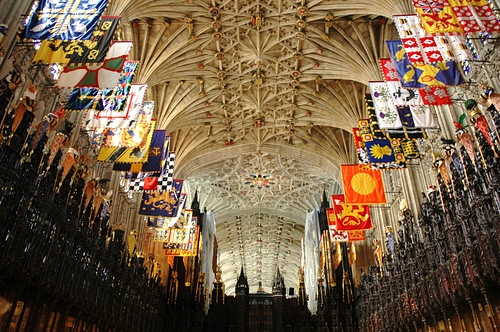
Death & Successor
Edward IV was rather too fond of his favourite foods and wines as he reached middle age, and he became seriously overweight. The king died, perhaps of a stroke at Westminster on 9 April 1483 CE, aged just 40. He was buried at Windsor Castle and succeeded by his eldest son, Edward, then only 12 years old (b. 1470 CE). The young Edward V of England would only reign from April to June, and he never even had time to have a coronation. Edward and his younger brother Richard (b. 1473 CE) were imprisoned in the Tower of London where they became known as the 'Princes in the Tower'. The boys were never seen outside the castle again, murdered most likely by their uncle and regent, the Protector of the Realm, Richard, the Duke of Gloucester, or so the later Tudor historians and William Shakespeare (1564-1616 CE) would have us believe. Curiously, the Duke of Gloucester had been on duty in the Tower of London the night of Henry VI's murder, but the princes' deaths remain one of the great mysteries of English history. In 1483 CE the Duke made himself king, Richard III, but the Wars of the Roses rumbled on regardless, and Richard was killed at the Battle of Bosworth Field in August 1485 CE. The victorious Henry Tudor of the House of Lancaster then became King Henry VII of England (r. 1485-1509 CE) and, marrying Elizabeth of York, daughter of Edward IV in 1486 CE, the two rival houses were finally united and a new one created: the Tudors.
